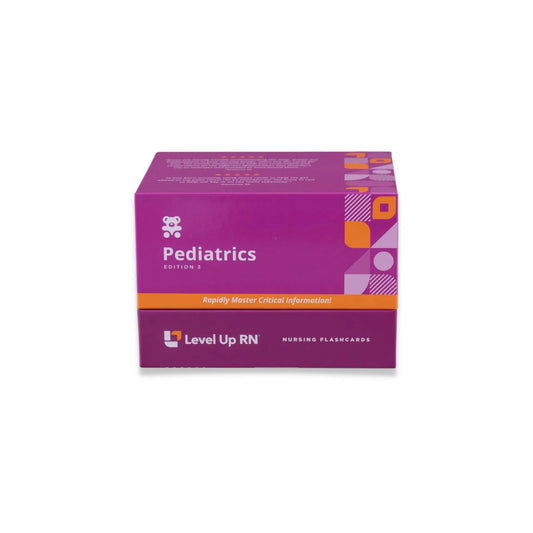Pediatric Nursing - Flashcards
In this article, we discuss types of child abuse, reporting requirements, and the signs of that abuse.
This subject matter may be difficult for some people; if you find this material discomfiting, please feel free to move on to our next video.
The Pediatric Nursing series follows along with our Pediatric Nursing Flashcards, which are intended to help nurses and nursing students learn and retain information about caring for pediatric patients. The flashcards are a clear, complete study tool and a helpful reference for practicing RNs, PNs, and other medical professionals.
Types of Abuse
There are four major types of abuse as it relates to children:
Physical abuse: the intentional use of physical force against a child. This could be hitting, kicking, shaking, burning, or anything that could cause physical harm to a child.
Emotional abuse: behaviors that could harm a child's sense of self-worth, self-esteem, or emotional well-being. These include name-calling, shaming, or rejection.
Sexual abuse: forcing a child to engage in sexual acts such as fondling or penetration.
Neglect: the failure to meet a child's basic physical needs, for example, providing housing or food, education, or access to medical care. All are forms of neglect.
We’ll discuss each of these in more detail below.
Signs of abuse
The signs of abuse and the nursing care of patients who have been abused are also covered in our Psychiatric Mental Health Nursing Flashcards, and Cathy explains more about signs of abuse.
These are the general signs of abuse to keep in mind.
Incompatibility between the story and the injury
If there is an inconsistency between the story of how an injury happened, and the injury itself, then that is suspect for abuse. For example, if a parent says, “My three-month-old crawled over to the stairs and fell down the stairs,” that is highly unlikely because a three-month-old would not have reached the crawling stage yet. Infants usually begin to crawl between 8-10 months.
Inconsistent story between the child and the caregiver
Related to this is an inconsistent story between the child and the caregiver. If the caregiver says one thing, but the child says another, even if neither one of them is saying anything about abuse, the inconsistency in the stories is a red flag that an injury could have resulted from abuse.
Injuries that are extremely unlikely given the child’s development
An example of this is a two-month-old who, according to the caregiver, “Crawled off the bed and hit his head.” A two-month-old is not able to crawl yet, making this set of events unlikely. And while it is possible for a two-month old to fall off a bed, the idea the child is crawling is unusual. Similarly, a child with burn injuries, for example, a four-month old, who “must have turned the bathwater on and fallen in” is another unlikely set of circumstances because it does not comport with the child’s developmental age.
Injuries that should have been avoided with basic parental supervision
As noted in the previous article, proper supervision is paramount to keeping children safe. From correct use of car seats to locking away poisons or locking access to swimming pools, most childhood injuries can be prevented with basic parental or caregiver supervision.
Risk factors
Remember that risk factors are based on the aggregation of data. This does not mean that somebody with these specific risk factors is going to abuse a child. It just means that a particular risk factor has been shown, through data, to be linked to something that might relate to abuse or abusive behavior.
Risk factors for abuse include children who are less than four years old or who have special needs, for example, if they have illnesses or disabilities. Consider that these children are the most demanding — an infant cries frequently, and a child who has an illness or disability needs extra attention.
A family history of mental health issues or substance abuse can put a child at risk for abuse.
Inconsistent, transient, or non-biological caregivers are also risk factors, as these people might not feel as committed to the children in their care as the children’s family members do.
Another risk factor is parents with low income or education levels, teenage parents, single parents, and parents who have many other young children.
Reporting requirements
Nurses are required to report suspicion of abuse. And, crucially, just because you report it, you do not have to provide proof. What is referred to as the “burden of proof” is not the nurse’s responsibility.
What is important to know is that nurses are mandated reporters. Mandated reporters are required to report suspicion of abuse. You do not have to provide proof, you just have to provide the facts and circumstances that lead you to suspect abuse. The documentation that you do can be of assistance to the patient for legal purposes.
To learn more about mandatory reporting, check out our Fundamentals of Nursing Flashcards.
Signs of abuse and neglect
Below we go into more detail about physical abuse, emotional abuse, sexual abuse, and neglect.
Physical abuse
Physical abuse is the intentional use of physical force. This could be hitting, kicking, shaking, burning, or anything that could cause physical harm.
Signs of physical abuse
One sign of abuse is multiple injuries — for example, multiple fractures or many bruises that are in various stages of healing.
Another possible sign of abuse is bruises on the cheek, neck, genitals, buttocks, or back.
Remember that children get a lot of bruises when they're small, accidental bruises over their bony provinces, such as the knees or elbows or shins. That’s because they are running around, climbing, falling down, bumping into objects, etc. But these sorts of injuries do not usually occur in soft tissue areas. So a child with bruises on non-bony parts of their body may have been abused.
Bruises in the shape of a causative object, such as a belt, are another sign of possible abuse.
Similarly, burns in the clear shape of an object could indicate abuse. For example, a burn in the shape of an iron or a cigarette burn. Also, what are known as immersion burns. So if someone puts a child in hot water intentionally (to cause pain) and it results in a burn, we would see those immersion burns — often with a clear line of demarcation, where the burn begins or ends, for example, a child who has had their hand dipped in something scalding.
Another sign of abuse is spiral fractures. Spiral fractures occur when a long bone (e.g., the femur or humerus) is broken by a twisting force. The accidental causes of these are usually injuries from skiing, snowboarding, soccer, football, wrestling, or motorcycle accidents. A spiral fracture in a small child or infant is unlikely to be from these and can be a sign of abuse, for example, if the arm or leg was forcibly twisted.
Signs of shaken baby syndrome
The signs and symptoms of shaken baby syndrome include poor feeding, irritability, lethargy, vomiting, seizures, periods of apnea, and retinal hemorrhage (abnormal bleeding within the delicate blood vessels of the retina).
Shaken baby syndrome is a serious form of abuse inflicted on a child, usually occurring when a parent or other caregiver shakes a baby out of anger or frustration. Babies have weak neck muscles, which is why, when you hold them, you support their head. Shaking would cause the baby’s head to move dangerously back and forth, which could cause brain injury and head trauma.
Emotional abuse
Emotional abuse includes behaviors that could harm a child's sense of self-worth, self-esteem, or emotional well-being.
Signs of emotional abuse
The signs of emotional abuse may include a child who displays extreme behavior — they’re overly compliant or they are very demanding. Extreme passivity or aggression are other displays of extreme behavior.
Another sign of emotional abuse is delayed physical or emotional development. A child whose emotional needs are not being met may not be developing emotionally the way we would anticipate.
Sexual abuse
Sexual abuse: forcing a child to engage in sexual acts.
Signs of sexual abuse
The signs of sexual abuse include difficulty walking or sitting — a red flag for sexual abuse.
If a child exhibits advanced understanding or behavior sexually for their age — for example if a young child describes a specific sexual behavior or is seen demonstrating or attempting to demonstrate that behavior, especially with other children — that should be a red flag as well.
Other signs of sexual abuse include if a child has a sexually transmitted infection, an obvious sign of abusive contact. Additionally, a child with frequent urinary tract infections, especially in children with a vulva, may be experiencing abuse.
A new onset nocturnal enuresis (wetting the bed at night) could be a possible sign of sexual abuse.
Neglect
Neglect is the failure to meet a child's basic physical needs.
Signs of neglect
Neglect of a child might manifest in frequent absences from school. This is a red flag of neglect because no one is making sure that this child is going to school.
A child who is begging for food, or stealing food or money, is attempting to meet their own needs because their needs are not being met by their caregiver, another sign of neglect.
Unclean clothes, excessive body odor, and poor dental health could indicate neglect. As could a child who is dressing inappropriately for the weather
You can read more about nursing care for children who have been abused here.


